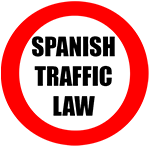1. It is forbidden to drive on motorways with animal-drawn vehicles, bicycles, motorcycles and vehicles for people with reduced mobility (article 18.1 of the articulated text).

Notwithstanding the provisions of the previous paragraph, riders of bicycles over 14 years old may ride on the hard shoulders of the motorways, unless, for justified reasons of road safety, they are prohibited by the appropriate signalling. Said prohibition will be complemented with a panel that reports the alternative route.

Under no circumstances will the use of bicycles be authorised on autopistas, but may be allowed on some autovías. You should check the autovía’s road signs to confirm which vehicles are forbidden.
Difference between an autopista and autovía
Technically, the difference between an autopista and autovía is in the design.
An autopista is a motorway for cars and land cargo with wide curves and runs at a constant maximum permitted speed of 120 kilometres per hour, not normally requiring a speed reduction (with exceptions).
2. Any driver who, for reasons of emergency, is forced to drive their vehicle on a motorway at abnormally reduced speed, regulated in article 49.1, must leave it by the first exit.

For safety reasons, if you suffer a breakdown on the motorway you should not continue driving on it, but leave at the nearest exit.
3. Those special vehicles or special transport systems that exceed the weights or dimensions established in the General Vehicle Regulations may travel, exceptionally, on motorways when this is indicated in the complementary authorisation that must be provided, and those that do not exceed said weights or dimensions, when, according to their characteristics, may drive faster than 60 kilometres per hour on level ground and comply with the conditions indicated in annex III of this regulation.

